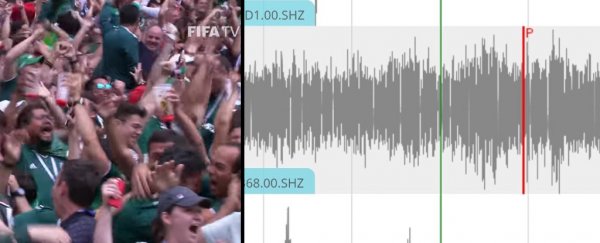When Mexico beat Germany 1–0 at the FIFA World Cup on Sunday, the upset was so stunning Earth literally shook at the shock result.
It wasn't natural seismic activity making the ground shake, though, but an artificial quake created entirely by celebrating Mexican fans, whose jumping elation at their team's unexpected triumph was thunderous enough to register on seismic detectors in Mexico City.
Mexican seismic and volcanism tracking agency SIMMSA picked up the tremors from at least two sensors, and suggested the shaking coincided with possible "massive jumps" in Mexico City when Mexico's Hirving Lozano gave his team a 1–0 lead with the only goal of the match.
El #sismo detectado en la Ciudad de México se originó de manera artificial. Posiblemente por saltos masivos durante el Gol de la selección de #México en el mundial. Por lo menos dos sensores dentro de la Ciudad lo detectaron a las 11:32. pic.twitter.com/mACKesab3b
— IIGEA A.C. (@IIGEAac) June 17, 2018
Chilean researchers with Sismologia Chile announced that they too picked up the phenomenon, which they confirmed occurred at the point when Lozano's strike beat German goalkeeper Manuel Neuer.
In a Facebook post, the Chilean seismologists described the "unnatural vibration" as being produced by "coordinated jumps of the fans".
Nuestros dispositivos de alerta sísmica de @SismoDetector también detectaron el sismo artificial en tiempo real, la aceleración máxima llegó a 37cm/s2. Al mismo momento del gol de #MEX ante #GER.
— Red Geocientífica de Chile (@RedGeoChile) June 17, 2018
These kinds of unnatural vibrations have been observed before at things like sporting events and massive outdoor music events, and according to Sismologia Chile, can be indeed considered as earthquake-like tremors, because vibration occurs in the ground and is detected by monitoring equipment.
However, they're clearly different from the kinds of earthquakes we usually talk about – those of natural origin – because they're not caused by tectonic or volcanic activity, and don't have a clear epicentre, since the agitation occurs at several points.
As a blog post by SIMMSA researchers explains, even while the ground shakes in these sorts of events, it still only creates a very minor earthquake compared to actual seismic activity, and generally can only be detected by sensitive equipment, or instruments located near the mass jumping.
Here's what the celebrations looked like in Mexico City:
👀that reaction from the Zocalo in Mexico City to Chucky Lozano's goal. pic.twitter.com/PcyHyfit9w
— FOX Soccer (@FOXSoccer) June 17, 2018
Update: While nobody's doubting that Mexican fans celebrated riotously enough to make the ground beneath their feet shake, at least some are questioning whether the tremors detected were accurately registered as an artificial earthquake like SIMMSA says.
Suzan van der Lee of Northwestern University inspected the seismic data disseminated by SIMMSA and embedded in news stories like ours and says it comes from personal seismographs typically purchased by hobbyists – not professional seismological equipment.
The upshot is the vibrations detected could be nothing more than minor shaking caused by a small group of people jumping near the devices.
Separate readings from a professional seismograph station at Mexico's Universidad Nacional Autónoma de México also appear to show no recognisable signals related to Lozano's goal, according to van der Lee, so it's possible SIMMSA's take on this Earth-shaking event might be a little unstable itself.
"This was big hype for nothing," van der Lee told The Washington Post.
"The signal shown could have been related to a family or two reacting to the goal, but the signals certainly do not stem from a mass celebration."
